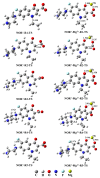Elucidating Direct Photolysis Mechanisms of Different Dissociation Species of Norfloxacin in Water and Mg2+ Effects by Quantum Chemical Calculations
- PMID: 29137112
- PMCID: PMC6150356
- DOI: 10.3390/molecules22111949
Elucidating Direct Photolysis Mechanisms of Different Dissociation Species of Norfloxacin in Water and Mg2+ Effects by Quantum Chemical Calculations
Abstract
The study of pollution due to combined antibiotics and metals is urgently needed. Photochemical processes are an important transformation pathway for antibiotics in the environment. The mechanisms underlying the effects of metal-ion complexation on the aquatic photochemical transformation of antibiotics in different dissociation forms are crucial problems in science, and beg solutions. Herein, we investigated the mechanisms of direct photolysis of norfloxacin (NOR) in different dissociation forms in water and metal ion Mg2+ effects using quantum chemical calculations. Results show that different dissociation forms of NOR had different maximum electronic absorbance wavelengths (NOR2+ < NOR⁰ < NOR⁺) and showed different photolysis reactivity. Analysis of transition states (TS) and reaction activation energies (Ea) indicated NOR⁺ generally underwent loss of the piperazine ring (C10-N13 bond cleavage) and damage to piperazine ring (N13-C14 bond cleavage). For NOR2+, the main direct photolysis pathways were de-ethylation (N7-C8 bond cleavage) and decarboxylation (C2-C5 bond cleavage). Furthermore, the presence of Mg2+ changed the order of the wavelength at maximum electronic absorbance (NOR⁺-Mg2+ < NOR⁰-Mg2+ < NOR2+-Mg2+) and increased the intensities of absorbance peaks of all three dissociation species of NOR, implying that Mg2+ played an important role in the direct photolysis of NOR⁰, NOR⁺, and NOR2+. The calculated TS results indicated that the presence of Mg2+ increased Ea for most direct photolysis pathways of NOR, while it decreased Ea for some direct photolysis pathways such as the loss of the piperazine ring and the damage of the piperazine ring of NOR⁰ and the defluorination of NOR⁺.
Keywords: DFT; Mg2+; direct photolysis pathways; ionic forms; norfloxacin.
Conflict of interest statement
The authors declare no conflict of interest.
Figures





Similar articles
-
DFT/TDDFT insights into effects of dissociation and metal complexation on photochemical behavior of enrofloxacin in water.Environ Sci Pollut Res Int. 2018 Oct;25(30):30609-30616. doi: 10.1007/s11356-018-3032-9. Epub 2018 Sep 3. Environ Sci Pollut Res Int. 2018. PMID: 30178400
-
Direct photochemistry of three fluoroquinolone antibacterials: norfloxacin, ofloxacin, and enrofloxacin.Water Res. 2013 Jan 1;47(1):439-48. doi: 10.1016/j.watres.2012.10.025. Epub 2012 Oct 22. Water Res. 2013. PMID: 23141476
-
Impact of dissolved organic matter on the photolysis of the ionizable antibiotic norfloxacin.J Environ Sci (China). 2015 Jan 1;27:115-23. doi: 10.1016/j.jes.2014.08.015. Epub 2014 Nov 13. J Environ Sci (China). 2015. PMID: 25597669
-
Influence of chemical speciation on photochemical transformation of three fluoroquinolones (FQs) in water: Kinetics, mechanism, and toxicity of photolysis products.Water Res. 2019 Jan 1;148:19-29. doi: 10.1016/j.watres.2018.10.027. Epub 2018 Oct 12. Water Res. 2019. PMID: 30343195
-
Photodegradation fate of different dissociation species of antidepressant paroxetine and the effects of metal ion Mg2+: Theoretical basis for direct and indirect photolysis.Chemosphere. 2023 Sep;335:139070. doi: 10.1016/j.chemosphere.2023.139070. Epub 2023 Jun 4. Chemosphere. 2023. PMID: 37279823
Cited by
-
Possibilities and Limitations of the Sono-Fenton Process Using Mid-High-Frequency Ultrasound for the Degradation of Organic Pollutants.Molecules. 2023 Jan 22;28(3):1113. doi: 10.3390/molecules28031113. Molecules. 2023. PMID: 36770778 Free PMC article.
-
DFT/TDDFT insights into effects of dissociation and metal complexation on photochemical behavior of enrofloxacin in water.Environ Sci Pollut Res Int. 2018 Oct;25(30):30609-30616. doi: 10.1007/s11356-018-3032-9. Epub 2018 Sep 3. Environ Sci Pollut Res Int. 2018. PMID: 30178400
References
MeSH terms
Substances
LinkOut - more resources
Full Text Sources
Other Literature Sources
Miscellaneous

